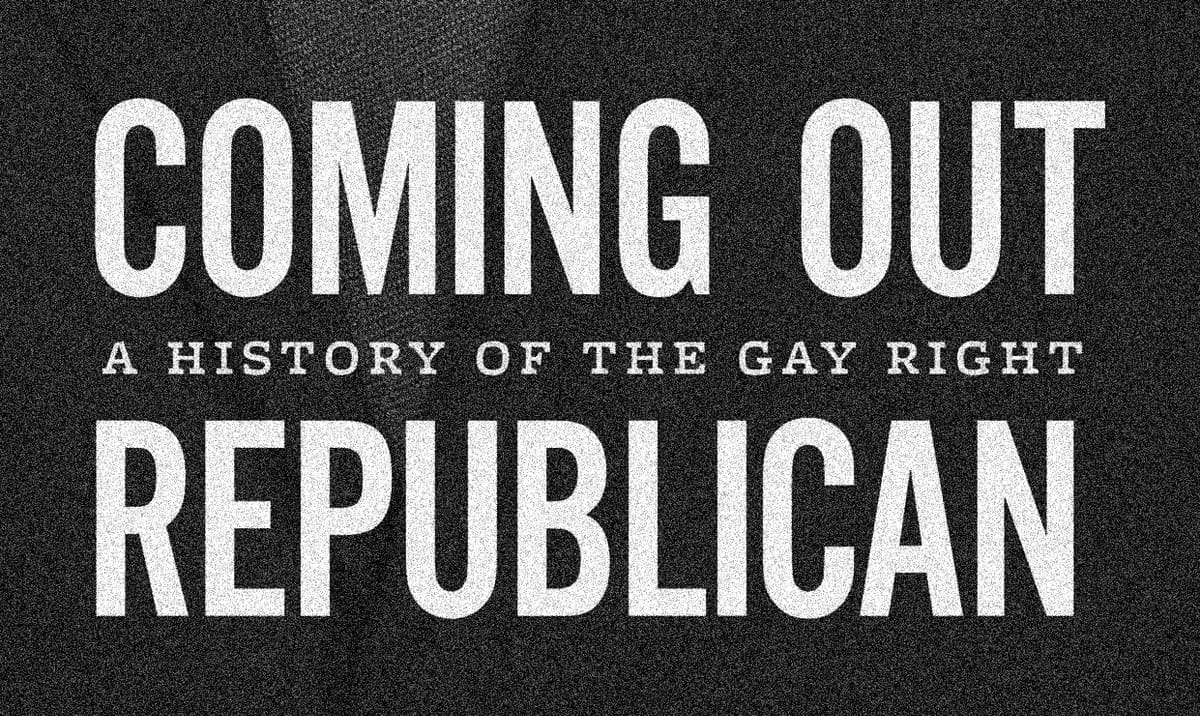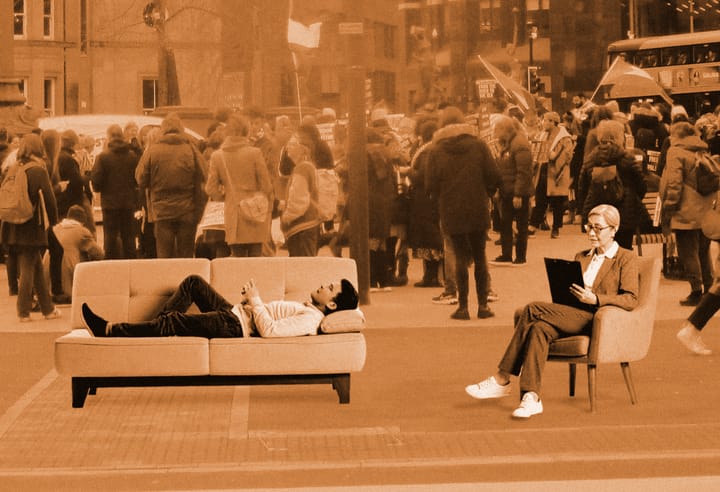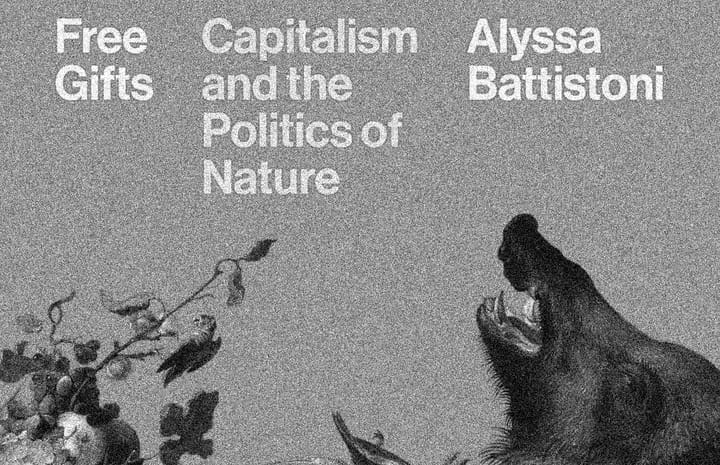The History of Gay Conservatism
LGBTQ voters overwhelmingly went for Harris, but the idea that gay voters are always going to be solidly blue is a myth.

Review of Neil J. Young’s Coming Out Republican: A History of the Gay Right (University of Chicago Press, 2024)
If November’s election was defined by the surprising rightward drift of several groups long considered reliable Democratic voters—black men, voters under 30, and Latinos, among others—there was one group that not only stayed loyal to the party, but even increased its support. According to NBC’s exit polling, 86% of LGBTQ voters cast ballots for Harris, a 15-point increase from the 71% that had voted for Biden in 2020. This sharp turn away from the Republicans came in the wake of J.D. Vance’s prediction that “normal gays” would vote for Trump; it may have been prodded by Trump’s “very clear anti-trans agenda” and “worries of rollbacks on marriage equality post Roe v. Wade,” as Allison Gash, a political science professor, explained to the Miami Herald. In any case, the 2024 LGBTQ vote appears to be the exception to the rule.
We thought we understood the mosaic of identity-based interest groups that have come to define the Democratic Party’s base. We’ve come to assume that members of sexual, racial, and ethnic minorities naturally align with modern liberalism and the Democratic Party, and we seek special explanations when they don’t. We think we know what identity is, and what sense of community, what sense of politics, should flow from it—if only we could get people to think logically about their own interests.
But in light of the recent defections among other groups once considered a stable part of the Democratic base, perhaps it’s time to question such assumptions. As Neil J. Young’s important new book, Coming Out Republican: A History of the Gay Right, shows, the relationship between one’s identity and one’s interests or politics isn’t always predictable or straightforward. In nineteen brisk, engaging, historically sequenced chapters, Young lays out some of the ways that gay (mostly) men have aligned not with Democratic Party or progressive politics but with conservative and Republican Party activism over the past 75 years.
He populates this history with colorful and often sympathetic figures whose lives illustrate a variety of paths to conservatism. Some were born into conservative middle-class, military, Catholic, or Protestant families and kept to their parents’ conservative way of thinking. A few rebelled against liberal parents. Some zigzagged more than once between Left and Right. Some hewed close to the spirit of classical liberalism, with its view of privacy and individualism, others to the reactionary logics of classical conservatism: reflexive fealty to God and country.
Consider the story of Dorr Legg, one of the founders of the mid-twentieth century homophile movement. Legg was born in 1904 to a prosperous, small-property-owning family in Ann Arbor, Michigan. Police harassment and an arrest for “gross indecency” in the late 1940s eventually drove him out of the state, and he headed west—to California, of course, where he worked as a landscape architect. Los Angeles had its own pervasive patterns of police surveillance and harassment, but the scale of the expanding city at least provided opportunities for making connections. There, he and his partner, Merton Bird, a black accountant, formed a support group for interracial gay couples. After going to Mattachine Society meetings for a few years, Legg helped found ONE, Inc. in 1952, which Young describes as a more conservative alternative to the left-influenced Mattachines. Shortly after ONE’s founding, Legg launched, edited, and wrote for the organization’s journal, One Magazine.
As editor of the magazine, Legg waged a long and ultimately successful legal war with the USPS, which had deemed a 1953 issue with the cover title “Homosexual Marriage?” obscene, and then again refused to circulate a 1954 issue that featured a lesbian love story. Piling on adjectives, the LA postmaster characterized the latter piece, “Sapho Remembered,” as “obscene, lewd, lascivious and filthy.” Legal challenges ensued. The FBI got in on the act at the urging of J. Edgar Hoover, who was annoyed by a piece suggesting that some of his organization’s top officials were homosexual. “We’ve got to get these bastards,” Hoover wrote in an angry note to his assistant (and rumored lover), Clyde Tolson. The irrepressible Legg stood down two G-men who came to his door that very day, refusing to cooperate and demanding to know their names. Along with the FBI, the Post Office continued harassing Legg and the publication until 1958, when the Supreme Court ruled in One’s favor. ONE, Inc. v. Olesen was no small victory: it cleared the way for gay magazines to publish and distribute.
One might think that such experiences would have pushed Legg to the left. But why? Democrats at the time weren’t much better than Republicans on matters of sexual privacy. The Truman administration had purged thousands of homosexuals and suspected homosexuals from government payrolls in the early 1950s, and the two parties vied to outdo each other with repressive policies during the Lavender Scares of the McCarthy period. Young also relates that Legg was unimpressed by some of his Mattachine colleagues’ constant talk about communism. But on practical matters related to gay rights, ONE sometimes took more militant positions than the Mattachines or Daughters of Bilitus, the lesbian group of the period. Legg’s important 1958 essay, “I Am Glad I Am Homosexual,” had struck members of the other organizations as imprudent and inflammatory. To Legg’s frustration and dismay, that same year ONE, Inc. failed to get the other homophile groups to sign on to a Homosexual Bill of Rights: the other organizations were more cautious, more committed to a slow process of educating the public.
So instead of pushing him to the left or into the arms of the Democrats, Legg’s experiences simply reinforced his midwestern Republican libertarianism, which revolved around privacy and individual rights. The “safeguarding of individual liberty from [the] tyranny of the majority” required the curbing of government powers, he concluded, and on these grounds, Legg remained a lifelong Republican. In 1977, the aging activist became a founding member of the Lincoln Republican Club of Southern California, which would soon rename itself the Log Cabin Club.
The same kind of countercultural libertarianism that defined Legg’s politics also shaped many other gay conservatives of the era. The Reverend Raymond Broshears—founder of the country’s first gay Republican club, the Teddy Roosevelt Republican Club—had moved around in the Midwest and upper South and lurched from one political position to another before coming to San Francisco in 1965 “to become a faggot,” as he put it. Broshears was a formidable and erratic figure who published Gay Crusader out of his Tenderloin apartment and ministered to street people, hustlers, trans women, old people, and other neglected members of the gay community. Over the years, he raged against police brutality and ubiquitous street violence against LGBT people; in 1973 he created the Lavender Panthers, an armed gay street patrol. But, Young writes, Broshears also resented “the short-sightedness of those he regularly dismissed as the ‘grand gays’ who ran the city’s social and political organizations and cozied up to the Democratic establishment,” which seemed to him hopelessly corrupt.
The libertarian variant of Republican Party politics predictably also appealed to gay men who were—unlike the down-and-out preacher and other social outcasts—relatively affluent, tax-adverse, and either self-employed or small business owners. (Think suits and ties, not funky street clothes—even if there might be cowboy hats or leather chaps on the weekend. Think upscale or gentrifying neighborhoods, not downscale or marginal communities.) In the late 70s, for example, Frank Ricchiazzi, a gay Vietnam veteran and Los Angeles real estate developer, was drawn into politics over the Briggs Initiative, a ballot measure sponsored by state representative John Briggs that would have barred gays and lesbians from teaching in the state’s public schools. Ricchiazzi, who went on to become an effective strategist for the Log Cabin Club in key legislative battles over gay rights in California, considered Briggs’ proposal for an employment ban a threat to freedom and a position anathema to Republican values of small government.
And if some openly gay men embraced libertarianism to campaign against discrimination, a number of closeted gay men were involved in supporting a more authoritarian version of Republicanism. In a telling illustration, Young recounts William F. Buckley Jr.’s 1964 meeting with Marvin Liebman and Robert Bauman. There, in the same room, on the brink of Goldwater’s historic defeat at the polls, three important actors in the conservative movement were already plotting how to snatch victory from the jaws of defeat, envisioning that Ronald Reagan might take up the conservative mantle. Buckley probably did not suspect that both of his close collaborators were homosexuals.
Born to immigrant parents in 1923, Liebman had been a Communist in his youth during the 1930s and 40s. By the 1950s, he was a staunch anticommunist, and in the process of switching sides, he had discovered a talent for fundraising. An early wizard of direct-mail fundraising, Liebman had kept the National Review funded and served as a networker, opinion-maker, and mentor in the nascent conservative movement. The anticommunist fundraiser always kept himself out of the limelight (a common strategy for closeted men of the period) but decided to come out of his own volition in 1990, in a famous exchange of letters with his friend Buckley.
Bauman, by contrast, rose through the ranks of the conservative movement in more visible roles. A cofounder of Young Americans for Freedom and Youth for Nixon in 1960, he later founded the American Conservative Union and went on to become the US House representative from Maryland’s Eastern Shore, winning a special election in 1973. The rising star of the conservative movement became a familiar face on C-SPAN, using the new medium as platform for anticommunist polemics and rightwing family values jeremiads on the floor of congress. He was “outed” in 1980 and lost his reelection bid when he was charged for soliciting a 16-year-old male sex worker.
One might think that these men’s encounters with homophobia and intolerance would have swayed them to oppose the rise of the modern Right, which, at the time, tilted against homosexuality and abortion in the name of family values. And this in fact was the prevailing tendency among gay men everywhere. But some conservative gay men compartmentalized: they were against abortion and tried to remain silent on the question of homosexuality. Others threw themselves into antigay politics with vigor while not-always-so-discreetly pursuing sexual liaisons after hours. And at the height of the Cold War, anti-communism, like the closet, functioned as a form of self-preservation, catapulting political careers to heights that could be maintained only so long as the secret was kept. “Unlike the fake names or exaggerated masculinity or femininity many gay men and lesbians often took on, the outspoken anti-communism these closeted conservative men used as part of their arsenal was sincere,” Young writes. “It allowed them to show themselves to be true conservatives, loyal Americans, and (importantly) not homosexual.”
In considering the myriad paths to conservatism taken by the men in Young’s book, it might be tempting to say that some had honorable intentions and others served shameful causes; that some were clear about their thinking while others were plagued by self-hatred. But this is not the most productive approach to parsing connections among identity, interests, and politics. If Young’s compendium of profiles shows us anything, it is that conservatism, and gay people’s reasons for adhering to it, is a varied thing—or better put, conservatism is not even a singular “thing,” but a shifting compendium of social, cultural, religious, and political values and orientations. Over time, some conservatives have adhered to one portion of this changing ensemble, others to another. The anticommunism that loomed large during the Cold War and shaped the politics of the closeted gay architects of the postwar Right doesn’t even register in the thinking of gay conservatives today—except perhaps for those on the alt-Right who fancifully imagine that they espy communism in corporate DEI programs and in the “woke” postures of their online opponents.
What perhaps goes understated in Young’s accounting is the extent to which all these variants of conservatism are undergirded by a certain rosy view of capitalism. In this view, society is best served by unfettered free markets—and of course low taxes and minimal government. This view is especially attractive to small and large property-holders, businesspeople, and the middle class. Modern liberals of course believe in capitalism, too—often just as vehemently as conservatives do—but with modifications: they believe in government, within limits, and think that markets function best when augmented by buffers, cushions, and modest redistributive policies.
Such were the political battle lines over much of the period covered by Young’s book. But in a political system such as ours, liberal and conservative, left and right, can only be correlative terms, and liberalism, too, is a changing ensemble of values and positions. Its economic ameliorative policies have become increasingly attenuated since Bill Clinton steered the Democratic Party decisively into the camp of neoliberalism in the 1990s. As a result, post-New Deal liberals have had increasing difficulty distinguishing their economic policies from those of conservatives. Instead, contemporary liberals have shifted to an understanding of interest groups organized around identity politics, and the pivot of liberal activism has turned increasingly to a subvariant of progressivism embraced by the educated professional strata.
Young warns that the Republican Party will eventually betray its gay—and other— supporters, if history is any judge. But it’s not entirely clear what betrayal might mean for either the Log Cabin Republicans, whose primary concerns are low taxes and a free market, or for voters who simply view their “interests” as something outside of the identity-based culture-war frameworks that contemporary progressives have insisted upon. “I’m not voting because of marriage equality, LGBTQ rights,” one gay Trump supporter told NBC in the lead-up to the 2024 election. “I’m voting because I want more money in my wallet. I want my community safe, and I want to be able to raise a family and know that they’re going to be safe in the future.” Shortly after winning the election, Trump announced Scott Bessent—a billionaire, a hedge fund manager, and also a gay man—as his pick for secretary of the Treasury. We can probably assume that at least some of Bessent’s interests were at the top of mind when he accepted.
Therein lies our challenge. We think we know what identities are and how they ought to align with political parties, along with what sorts of positions might appeal to this or that demographic, but the things we think we know are getting in the way of things we need to know, if we want to have a clearer picture of how things work—and perhaps especially if we want to found a new majoritarian politics based on universal programs.
■
Roger Lancaster is a professor of anthropology and cultural studies at George Mason University and author of The Struggle to be Gay—in Mexico, for Example.



